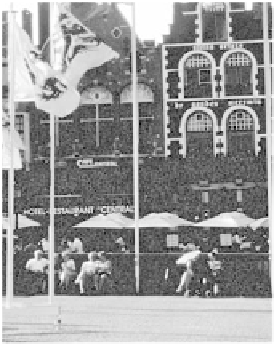Travel Reference
In-Depth Information
SIGHtS
These sights are listed in walking order, from Market Square, to
Burg Square, to the cluster of museums around the Church of Our
Lady, to the Begijnhof (10-min walk from beginning to end, with-
out stops). For a self-guided walk and more information on each
major sight,
J
see the Bruges City Walk, page 329.
s
market square (markt)
—Ringed by a bank, the post office,
lots of restaurant terraces, great old gabled buildings, and the
iconic bell tower, this is the modern heart of the city (most city
buses run from near here to the train station—it's a block down
Kuiperstraat at the library bus stop). Under the bell tower are
two great Belgian-style french-fry stands, a quadrilingual Braille
description of the old town, and a metal model of the tower. In
Bruges' heyday as a trading center, a canal came right up to this
square.
Geldmuntstraat, just off the square, is a delightful street
with many fun and practical shops and eateries.
ss
bell Tower (belfort)
—Most of this bell tower has presided
over Market Square since 1300, serenading passersby with carillon
music. The octagonal lantern was added in 1486, making it 290
feet high—that's 366 steps. The view is worth the climb and the
€5 (daily 9:30-17:00, last entry 45 min before closing, €0.40 WC
in courtyard).
ss
burg square
—his opulent square is Bruges' civic center,
historically the birthplace of Bruges and the site of the ninth-cen-
tury castle of the first count of Flanders. Today, it's an atmospheric
place to take in an outdoor concert while surrounded by six centu-
ries of architecture.
s
basilica of the Holy blood
—Originally the Chapel of Saint
Basil, this church is famous for its relic of the blood of Christ,
which, according to tradition, was brought to Bruges in 1150 after
the Second Crusade. The lower chapel is dark and solid—a fine



















